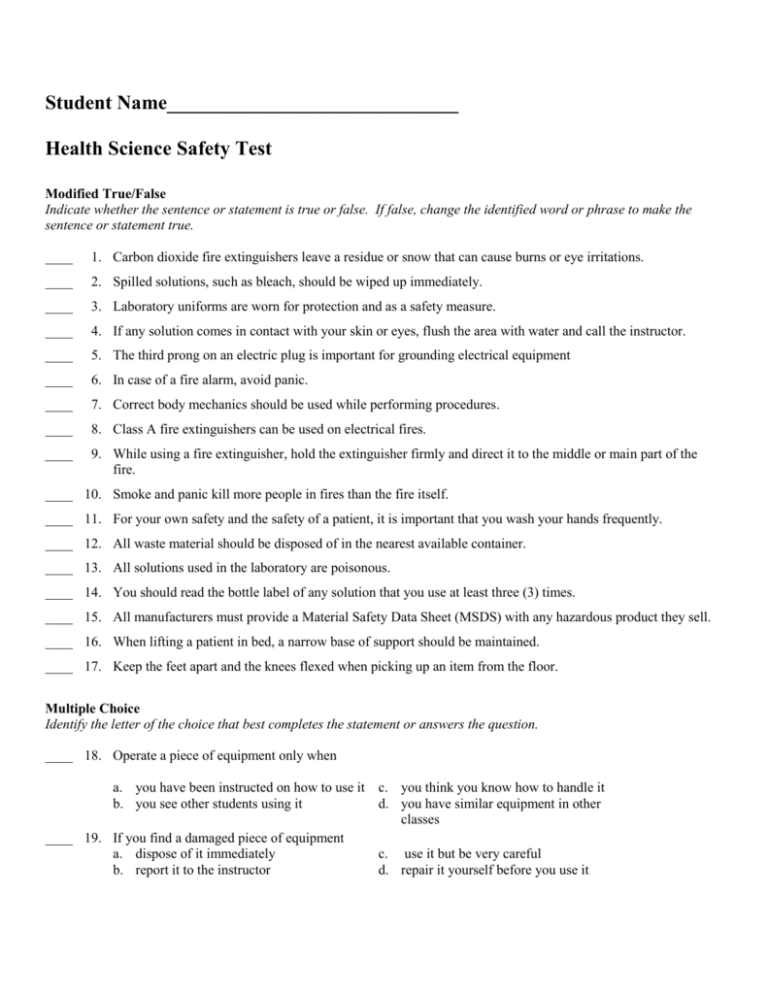Safety-Test
advertisement

Student Name_____________________________ Health Science Safety Test Modified True/False Indicate whether the sentence or statement is true or false. If false, change the identified word or phrase to make the sentence or statement true. ____ 1. Carbon dioxide fire extinguishers leave a residue or snow that can cause burns or eye irritations. ____ 2. Spilled solutions, such as bleach, should be wiped up immediately. ____ 3. Laboratory uniforms are worn for protection and as a safety measure. ____ 4. If any solution comes in contact with your skin or eyes, flush the area with water and call the instructor. ____ 5. The third prong on an electric plug is important for grounding electrical equipment ____ 6. In case of a fire alarm, avoid panic. ____ 7. Correct body mechanics should be used while performing procedures. ____ 8. Class A fire extinguishers can be used on electrical fires. ____ 9. While using a fire extinguisher, hold the extinguisher firmly and direct it to the middle or main part of the fire. ____ 10. Smoke and panic kill more people in fires than the fire itself. ____ 11. For your own safety and the safety of a patient, it is important that you wash your hands frequently. ____ 12. All waste material should be disposed of in the nearest available container. ____ 13. All solutions used in the laboratory are poisonous. ____ 14. You should read the bottle label of any solution that you use at least three (3) times. ____ 15. All manufacturers must provide a Material Safety Data Sheet (MSDS) with any hazardous product they sell. ____ 16. When lifting a patient in bed, a narrow base of support should be maintained. ____ 17. Keep the feet apart and the knees flexed when picking up an item from the floor. Multiple Choice Identify the letter of the choice that best completes the statement or answers the question. ____ 18. Operate a piece of equipment only when a. you have been instructed on how to use it c. you think you know how to handle it b. you see other students using it d. you have similar equipment in other classes ____ 19. If you find a damaged piece of equipment a. dispose of it immediately c. use it but be very careful b. report it to the instructor d. repair it yourself before you use it ____ 20. Solutions that will be used in the laboratory a. can be injurious,, so avoid eye and skin contact b. can be mixed together in most cases ____ 21. When the instructor is out of the room a. equipment should not be operated c. do not always need a label d. are all safe for your use c. it is a good time to experiment with equipment d. be extra careful when using equipment b. it is all right to operate equipment ____ 22. All injuries obtained in the laboratory a. should be treated by a fellow student c. should be washed with soap and water b. can be ignored if minor d. should be reported to the instructor ____ 23. If a particle gets in your eye, you should a. rub your eye c. call the instructor b. use cotton to remove it d. flush your eve with water to remove it ____ 24. When handling any electrical equipment, be sure to a. wash your hands immediately before c. plug equipment carefully into any socket handling it b. check first for damaged cords or improper d. ask for written instructions on how to use grounds it ____ 25. Horseplay or practical jokes a. are permitted if no one is insulted c. cause accidents and have no place in the lab b. may be done during breaks or study time d. usually do not result in accidents ____ 26. The major cause of fires is a. smoking and matches c. improper rubbish disposal b. defects in heating systems d. misuse of electricity ____ 27. The three things needed to start a fire are a. air, oxygen, and fuel c. fuel, carbon dioxide, and heat b. fuel, heat, and oxygen d. air, carbon dioxide, and fuel ____ 28. Injuries are more likely to happen to persons who a. take chances c. practice safety b. use equipment properly d. respect the dangers in using equipment ____ 29. If your personal safety is in danger because of fire a. get the fire extinguisher and put it out c. leave the area quietly and in an orderly fashion b. run out of the area as fast as you can d. open all windows and doors ____ 30. Wearing safety glasses in a laboratory a. is never necessary c. is a requirement at all times b. should be done if you think it is necessary d. is required for certain procedures Essay 31. What is OSHA? What is its purpose? 32. Identify the three (3) main diseases that can be contracted by exposure to body fluids. Safety Test Answer Section MODIFIED TRUE/FALSE 1. 2. 3. 4. 5. 6. 7. 8. 9. 10. 11. 12. 13. 14. 15. 16. 17. ANS: True ANS: False ANS: True ANS: True ANS: True ANS: True ANS: True ANS: False ANS: False ANS: True ANS: True ANS: False ANS: False ANS: True ANS: True ANS: False ANS: True MULTIPLE CHOICE 18. ANS: 1. A 19. ANS: 2. B 20. ANS: 3. A 21. ANS: 4. A 22. ANS: 5D 23. ANS: 6. C 24. ANS: 7. B 25. ANS: 8. C 26. ANS: 9. A 27. ANS: 10. B 28. ANS: 10. A 29. ANS: 11. C 30. ANS: 13. D ESSAY 31. ANS: Occupational Health and Safety Administration; to establish and enforce standards for the workplace 32. ANS: hepatitis B, hepatitis C, and acquired immune deficiency syndrome (AIDS)







